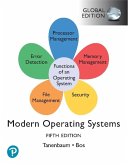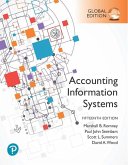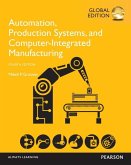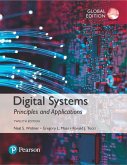A fresh, contemporary, active introduction to information systems
Introduction to Information Systems provides invaluable help for learning the knowledge and skills related to information systems. In it, students see clearly what information systems are all about and why they are so fundamental to business and society.
Packed with revelations about business strategies, technology trends and innovations–plus tips to help students work smarter, and more efficiently– Introduction to Information Systems provides a better teaching and learning experience–for you and your students. Here’s how:
A focus on reaching all students, recognizing changing student roles, and showing clearly where the knowledge of information systems skills can take them.
Helping students see beyond today’s classrooms and into today’s varied world.
End-of-book comprehensive case studies show students the concepts in action.
MyMISLab not included. Students, if MyMISLab is a recommended/mandatory component of the course, please ask your instructor for the correct ISBN and course ID. MyMISLab should only be purchased when required by an instructor. Instructors, contact your Pearson representative for more information.
MyMISLab is an online homework, tutorial, and assessment product designed to personalize learning and improve results. With a wide range of interactive, engaging, and assignable activities, students are encouraged to actively learn and retain tough course concepts.
Features + Benefits
This title is a Pearson Global Edition. The Editorial team at Pearson has worked closely with educators around the world to include content which is especially relevant to students outside the United States.
A focus on reaching all students, recognizing changing student roles, and showing clearly where the knowledge of information systems skills can take them
The Human Element in Information Systems: The fresh perspective this text brings to an introduction course on information systems combines comprehensive, up-to-date coverage with a stronger focus on the human element in businesses, nonprofits, and other organizations. All the major topics are covered in a rigorous way, and enriched with probing discussions about the roles people play in building, shaping, implementing, and sometimes obstructing information systems.
Reaching a Changing Student Body: Recognizing the growth in the number of women, minorities, international students, online students, and nontraditional studies who enroll in this course, the text draws on examples and settings that will resonate with these groups and make the connections.
Changing Student Roles: This text recognizes that while some students will become information systems managers, many more will enter professions as consultants, business analysts, accountants, marketing professionals, talent development specialists, volunteers, virtual team leaders, forensic experts, legal advisors, and project managers, while also introducing emerging professions, such as data scientists. These roles are featured in the text’s examples, case studies, and simulations.
Inspiring Students to Pursue Promising Careers: With the goal of conveying the excitement and potential of the field of information systems, the text includes countless examples of how savvy men and women leverage information systems to transform organizations, and even build new empires. Included are many job descriptions, job growth rates, and projected salaries.
Working Smarter Not Harder–Productivity Tips for Students: Each chapter includes several “Productivity Tips” that suggest ways students can improve their own productivity by applying what they’ve learned.
Helping students see beyond today’s classrooms and into today’s varied world
Exploring Technology Battlegrounds: Students come to understand the close links between competitive business strategies and information systems and develop an awareness and new appreciation for the fierce business competitions they see around them as they look at online ads, privacy policies, social networks, and their own smartphones.
NEW! Expanded discussion of mobile devices and m-commerce in Chapter 6 includes a review of evolving mobile payment technologies using near field communications and strategies for mobile-friendly software development.
NEW! The “Internet of Things” is highlighted in several chapters, illustrating its growing impact on network architecture and bandwidth, and its rapidly increasing role in data collection, analysis, privacy, and surveillance.
NEW! Expanded discussion of cloud computing, personal clouds, mobility, and the BYOD (bring your own device) trend is presented, especially as they affect strategic planning for organizations.
Balancing Coverage of Business, Government, and Nonprofits: The varied settings in which students work, or will work, are covered in this new editions as it draws on timely examples from multinational corporations, nonprofits, government agencies, midsized businesses, start-ups, charities, volunteer organizations, student clubs, and other settings.
Highlighting Globalization and International Contexts: Examples of how information systems plays a key role in globalization about throughout the text to show students first hand instances such as how Baidu captured the search engine market in China, or how Idea manages a global supply chain.
Emphasizing Ethics: Ethical concerns are woven throughout the text, touching on very human ethical dilemmas and the choices that have to be made. A special feature in each chapter, The Ethical Factor, explores timely ethical issues such as corporate responsibility in extended supply chains, or the ethics of massive surveillance and collection of big data by governments and corporations.
NEW! Extended coverage of big data and the technologies used to store and analyze it has been added, along with a new “Ethical Factor” box that explores the ethics of big data.
NEW! The change in the title to Introduction to Information Systems better reflects the contents and the course.
End-of-book comprehensive case studies show students the concepts in action. Included are:
NEW! A new, comprehensive case study at the end of the text charts Apple’s disruptive innovations, and encourages, students to predict the company’s future business strategy. Case Study #3: “Apple: Can the Company Pull Off Another Disruptive Innovation?” (replaces case on Clearwire).
NEW! Twitter’s role in social TV and the “multiscreening” phenomenon are featured in a new case study about Nielsen’s program rating system to help students see how tweeting fits into the entertainment industry’s strategies.
Updated Red Cross case now includes the Safe and Well Website.
Updated and Revised Facebook case now covers the uproar over Instagram’s privacy and ownership challenges.
Updated “Managing the Federal Government’s IT Project Portfolio” now incorporates (recent steps by federal government to get control over IT spending.
MyMISLab not included. Students, if MyMISLab is a recommended/mandatory component of the course, please ask your instructor for the correct ISBN and course ID. MyMISLab should only be purchased when required by an instructor. Instructors, contact your Pearson representative for more information.
Personalize learning through the interactive, online role-playing simulations in MyMISLabTM: Students get opportunities to apply their knowledge and actually experience what each chapter is about, rather than simply memorizing key terms and concepts.
MyMISLab for Introduction to Information Systems creates learning experiences that are truly personalized and continuously adaptive. MyMISLab reacts to how students are actually performing, offering data-driven guidance that helps them better absorb course material and understand difficult concepts–resulting in better performance in the course. A dynamic set of tools for gauging individual and class progress means educators can spend less time grading and more time teaching.
Combining resources that illuminate content with accessible self-assessment, Pearson’s MyLab provides students with a complete digital learning experience — all in one place.
Interactive online role-playing simulations: Throughout this text, students enter realistic and often tense situations interacting with characters via simulations on their smartphones or laptops.
NEW! The online simulations are converted to HTML5, making them accessible from iPads and iPhones, and the scores go into the MyMISLab gradebook.
Examples of the simulations include:
Interviewing candidates for a wild animal preserve CIO.
Debating the best marketing pitch for a candy maker using web ana
Information Systems and People
Information Systems and Strategy
Information and Communications
Technologies: The Enterprise Architecture
Databases and Data Warehouses
Information Systems for the Enterprise
The Web, E-Commerce, and M-Commerce
Business Intelligence and Decision Making
Collaborating with Technology
Knowledge Management and E-Learning
Ethics, Privacy, and Security
Systems Development and Procurement
Project Management and Strategic Planning
Case Studies:
Facebook and Instagram: Privacy Challenges
A Humanitarian Supply Chain for the Red Cross
Apple: Can the Company Pull Off Another Disruptive Innovation?
Managing the Federal Government’s IT Project Portfolio
Hinweis: Dieser Artikel kann nur an eine deutsche Lieferadresse ausgeliefert werden.
Introduction to Information Systems provides invaluable help for learning the knowledge and skills related to information systems. In it, students see clearly what information systems are all about and why they are so fundamental to business and society.
Packed with revelations about business strategies, technology trends and innovations–plus tips to help students work smarter, and more efficiently– Introduction to Information Systems provides a better teaching and learning experience–for you and your students. Here’s how:
A focus on reaching all students, recognizing changing student roles, and showing clearly where the knowledge of information systems skills can take them.
Helping students see beyond today’s classrooms and into today’s varied world.
End-of-book comprehensive case studies show students the concepts in action.
MyMISLab not included. Students, if MyMISLab is a recommended/mandatory component of the course, please ask your instructor for the correct ISBN and course ID. MyMISLab should only be purchased when required by an instructor. Instructors, contact your Pearson representative for more information.
MyMISLab is an online homework, tutorial, and assessment product designed to personalize learning and improve results. With a wide range of interactive, engaging, and assignable activities, students are encouraged to actively learn and retain tough course concepts.
Features + Benefits
This title is a Pearson Global Edition. The Editorial team at Pearson has worked closely with educators around the world to include content which is especially relevant to students outside the United States.
A focus on reaching all students, recognizing changing student roles, and showing clearly where the knowledge of information systems skills can take them
The Human Element in Information Systems: The fresh perspective this text brings to an introduction course on information systems combines comprehensive, up-to-date coverage with a stronger focus on the human element in businesses, nonprofits, and other organizations. All the major topics are covered in a rigorous way, and enriched with probing discussions about the roles people play in building, shaping, implementing, and sometimes obstructing information systems.
Reaching a Changing Student Body: Recognizing the growth in the number of women, minorities, international students, online students, and nontraditional studies who enroll in this course, the text draws on examples and settings that will resonate with these groups and make the connections.
Changing Student Roles: This text recognizes that while some students will become information systems managers, many more will enter professions as consultants, business analysts, accountants, marketing professionals, talent development specialists, volunteers, virtual team leaders, forensic experts, legal advisors, and project managers, while also introducing emerging professions, such as data scientists. These roles are featured in the text’s examples, case studies, and simulations.
Inspiring Students to Pursue Promising Careers: With the goal of conveying the excitement and potential of the field of information systems, the text includes countless examples of how savvy men and women leverage information systems to transform organizations, and even build new empires. Included are many job descriptions, job growth rates, and projected salaries.
Working Smarter Not Harder–Productivity Tips for Students: Each chapter includes several “Productivity Tips” that suggest ways students can improve their own productivity by applying what they’ve learned.
Helping students see beyond today’s classrooms and into today’s varied world
Exploring Technology Battlegrounds: Students come to understand the close links between competitive business strategies and information systems and develop an awareness and new appreciation for the fierce business competitions they see around them as they look at online ads, privacy policies, social networks, and their own smartphones.
NEW! Expanded discussion of mobile devices and m-commerce in Chapter 6 includes a review of evolving mobile payment technologies using near field communications and strategies for mobile-friendly software development.
NEW! The “Internet of Things” is highlighted in several chapters, illustrating its growing impact on network architecture and bandwidth, and its rapidly increasing role in data collection, analysis, privacy, and surveillance.
NEW! Expanded discussion of cloud computing, personal clouds, mobility, and the BYOD (bring your own device) trend is presented, especially as they affect strategic planning for organizations.
Balancing Coverage of Business, Government, and Nonprofits: The varied settings in which students work, or will work, are covered in this new editions as it draws on timely examples from multinational corporations, nonprofits, government agencies, midsized businesses, start-ups, charities, volunteer organizations, student clubs, and other settings.
Highlighting Globalization and International Contexts: Examples of how information systems plays a key role in globalization about throughout the text to show students first hand instances such as how Baidu captured the search engine market in China, or how Idea manages a global supply chain.
Emphasizing Ethics: Ethical concerns are woven throughout the text, touching on very human ethical dilemmas and the choices that have to be made. A special feature in each chapter, The Ethical Factor, explores timely ethical issues such as corporate responsibility in extended supply chains, or the ethics of massive surveillance and collection of big data by governments and corporations.
NEW! Extended coverage of big data and the technologies used to store and analyze it has been added, along with a new “Ethical Factor” box that explores the ethics of big data.
NEW! The change in the title to Introduction to Information Systems better reflects the contents and the course.
End-of-book comprehensive case studies show students the concepts in action. Included are:
NEW! A new, comprehensive case study at the end of the text charts Apple’s disruptive innovations, and encourages, students to predict the company’s future business strategy. Case Study #3: “Apple: Can the Company Pull Off Another Disruptive Innovation?” (replaces case on Clearwire).
NEW! Twitter’s role in social TV and the “multiscreening” phenomenon are featured in a new case study about Nielsen’s program rating system to help students see how tweeting fits into the entertainment industry’s strategies.
Updated Red Cross case now includes the Safe and Well Website.
Updated and Revised Facebook case now covers the uproar over Instagram’s privacy and ownership challenges.
Updated “Managing the Federal Government’s IT Project Portfolio” now incorporates (recent steps by federal government to get control over IT spending.
MyMISLab not included. Students, if MyMISLab is a recommended/mandatory component of the course, please ask your instructor for the correct ISBN and course ID. MyMISLab should only be purchased when required by an instructor. Instructors, contact your Pearson representative for more information.
Personalize learning through the interactive, online role-playing simulations in MyMISLabTM: Students get opportunities to apply their knowledge and actually experience what each chapter is about, rather than simply memorizing key terms and concepts.
MyMISLab for Introduction to Information Systems creates learning experiences that are truly personalized and continuously adaptive. MyMISLab reacts to how students are actually performing, offering data-driven guidance that helps them better absorb course material and understand difficult concepts–resulting in better performance in the course. A dynamic set of tools for gauging individual and class progress means educators can spend less time grading and more time teaching.
Combining resources that illuminate content with accessible self-assessment, Pearson’s MyLab provides students with a complete digital learning experience — all in one place.
Interactive online role-playing simulations: Throughout this text, students enter realistic and often tense situations interacting with characters via simulations on their smartphones or laptops.
NEW! The online simulations are converted to HTML5, making them accessible from iPads and iPhones, and the scores go into the MyMISLab gradebook.
Examples of the simulations include:
Interviewing candidates for a wild animal preserve CIO.
Debating the best marketing pitch for a candy maker using web ana
Information Systems and People
Information Systems and Strategy
Information and Communications
Technologies: The Enterprise Architecture
Databases and Data Warehouses
Information Systems for the Enterprise
The Web, E-Commerce, and M-Commerce
Business Intelligence and Decision Making
Collaborating with Technology
Knowledge Management and E-Learning
Ethics, Privacy, and Security
Systems Development and Procurement
Project Management and Strategic Planning
Case Studies:
Facebook and Instagram: Privacy Challenges
A Humanitarian Supply Chain for the Red Cross
Apple: Can the Company Pull Off Another Disruptive Innovation?
Managing the Federal Government’s IT Project Portfolio
Hinweis: Dieser Artikel kann nur an eine deutsche Lieferadresse ausgeliefert werden.








